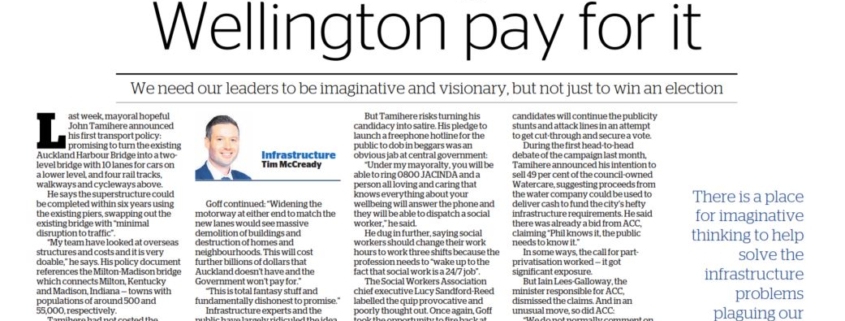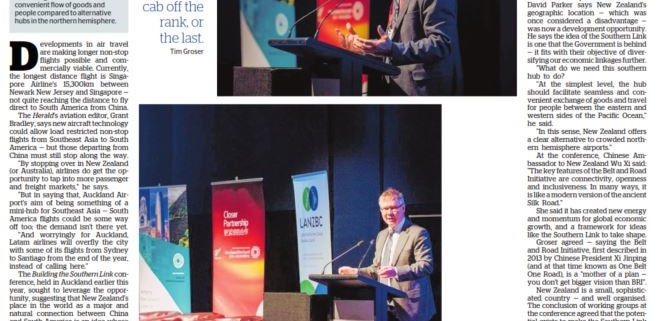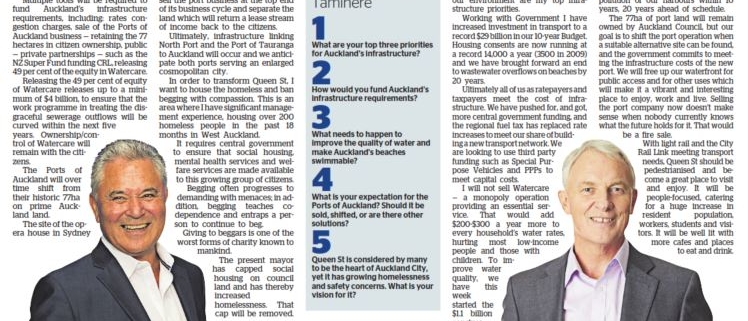Opinion: Build a bridge, make Wellington pay for it (NZ Herald)
Last week, mayoral hopeful John Tamihere announced his first transport policy: promising to turn the existing Auckland Harbour Bridge into a two-level bridge with 10 lanes for cars on a lower level, and four rail tracks, walkways and cycleways above.
He says the superstructure could be completed within six years using the existing piers, swapping out the existing bridge with “minimal disruption to traffic”.
“My team have looked at overseas structures and costs and it is very doable,” he says. His policy document references the Milton-Madison bridge which connects Milton, Kentucky and Madison, Indiana — towns with populations of around 500 and 55,000, respectively.
Tamihere had not costed the proposal at the time of the announcement — but suggested he expects the New Zealand Transport Agency to pay for it.
Minutes after the announcement, Mayor Phil Goff shot back on twitter, claiming the bridge would cost over $10b to build and suggesting Tamihere either “intends to bankrupt the city, burden ratepayers with massive extra rates or he is making it up because he knows he is never going to deliver it.”
Goff continued: “Widening the motorway at either end to match the new lanes would see massive demolition of buildings and destruction of homes and neighbourhoods. This will cost further billions of dollars that Auckland doesn’t have and the Government won’t pay for.”
“This is total fantasy stuff and fundamentally dishonest to promise.”
Infrastructure experts and the public have largely ridiculed the idea, with some drawing parallels to President Trump’s border wall, which he insisted Mexico would pay for.
The comparison has been made before, to which Tamihere said: “it’s a very poor simile for me. I’m not a billionaire, I’m not a big white guy, my wife sold my golf clubs a long time ago… While I’m forthright, I like to be as respectful as I can be… To use a lazy simile like that on me, you’d have to actually express some specificity about that and give some evidence.”
But Tamihere risks turning his candidacy into satire. His pledge to launch a freephone hotline for the public to dob in beggars was an obvious jab at central government:
“Under my mayoralty, you will be able to ring 0800 JACINDA and a person all loving and caring that knows everything about your wellbeing will answer the phone and they will be able to dispatch a social worker,” he said.
He dug in further, saying social workers should change their work hours to work three shifts because the profession needs to “wake up to the fact that social work is a 24/7 job”.
The Social Workers Association chief executive Lucy Sandford-Reed labelled the quip provocative and poorly thought out. Once again, Goff took the opportunity to fire back at Tamihere on twitter:
“John Tamihere’s plan to set up 0800 JACINDA to report homeless people is a political stunt that demeans the seriousness of the issue. While Tamihere might be happy to criminalise homelessness, I believe we should be providing support to our most vulnerable.”
We know that local elections can be notoriously dull. Auckland’s turnout for 2016 was only 38 per cent.
As the election draws closer, candidates will continue the publicity stunts and attack lines in an attempt to get cut-through and secure a vote.
During the first head-to-head debate of the campaign last month, Tamihere announced his intention to sell 49 per cent of the council-owned Watercare, suggesting proceeds from the water company could be used to deliver cash to fund the city’s hefty infrastructure requirements. He said there was already a bid from ACC, claiming “Phil knows it, the public needs to know it.”
In some ways, the call for part-privatisation worked — it got significant exposure.
But Iain Lees-Galloway, the minister responsible for ACC, dismissed the claims. And in an unusual move, so did ACC:
“We do not normally comment on potential or actual investment opportunities; however, in this case, in relation to Watercare, we confirm that ACC has not received any investment proposal nor are we aware of any sales process.”
There is a place for imaginative thinking to help solve the infrastructure problems plaguing our biggest city. It’s just a shame they tend to be presented as hasty and ill-thought-out ideas, eight weeks out from an election.



